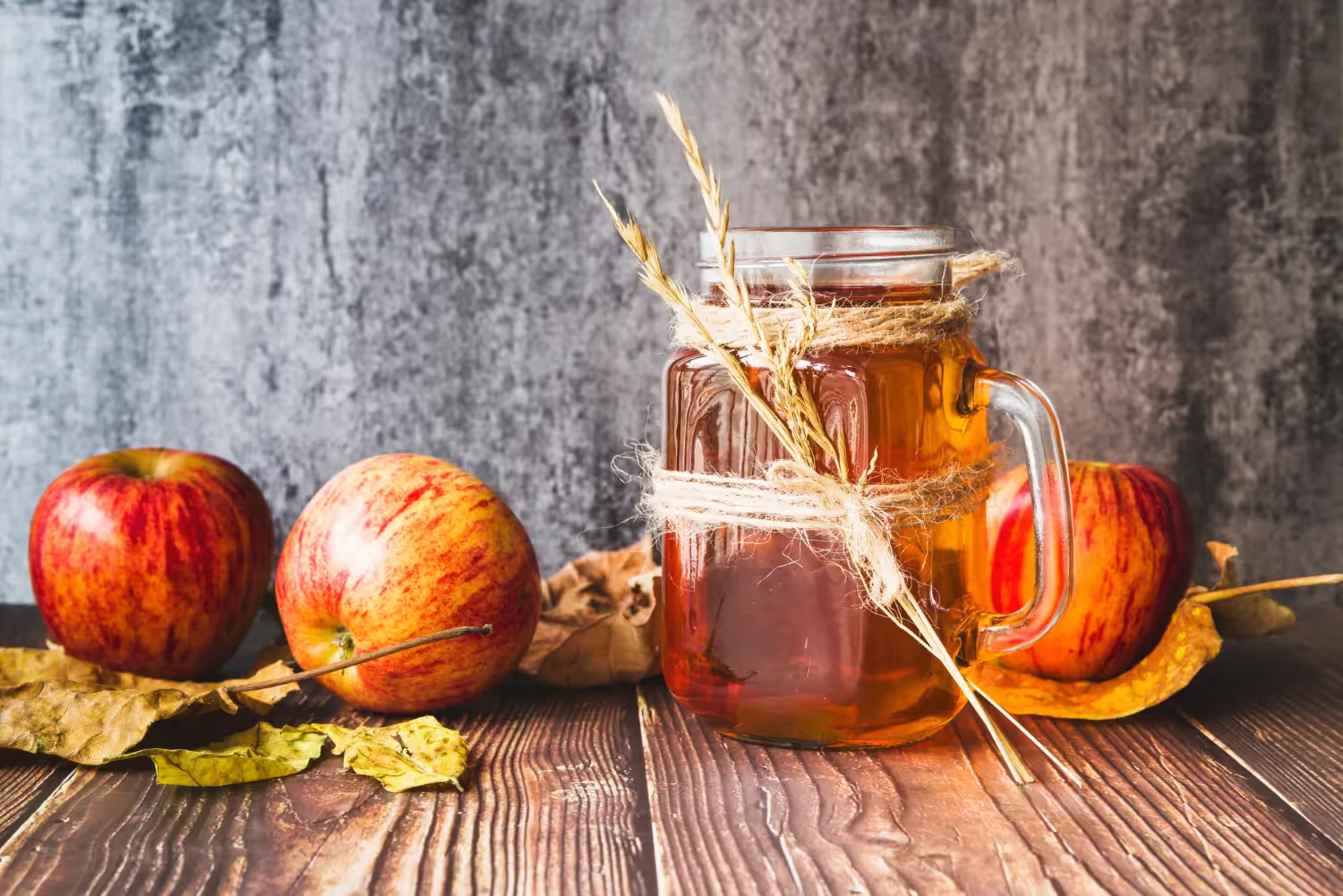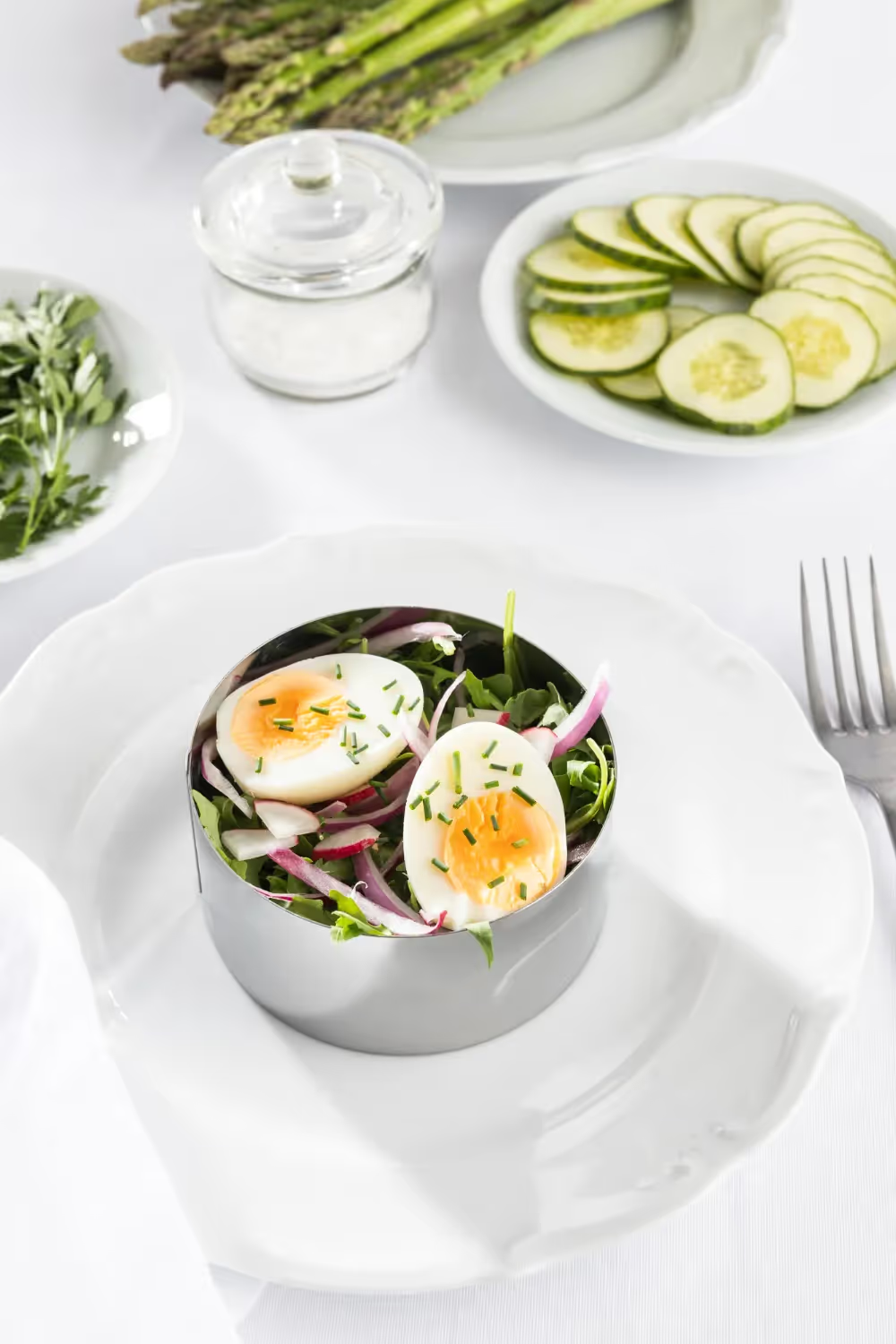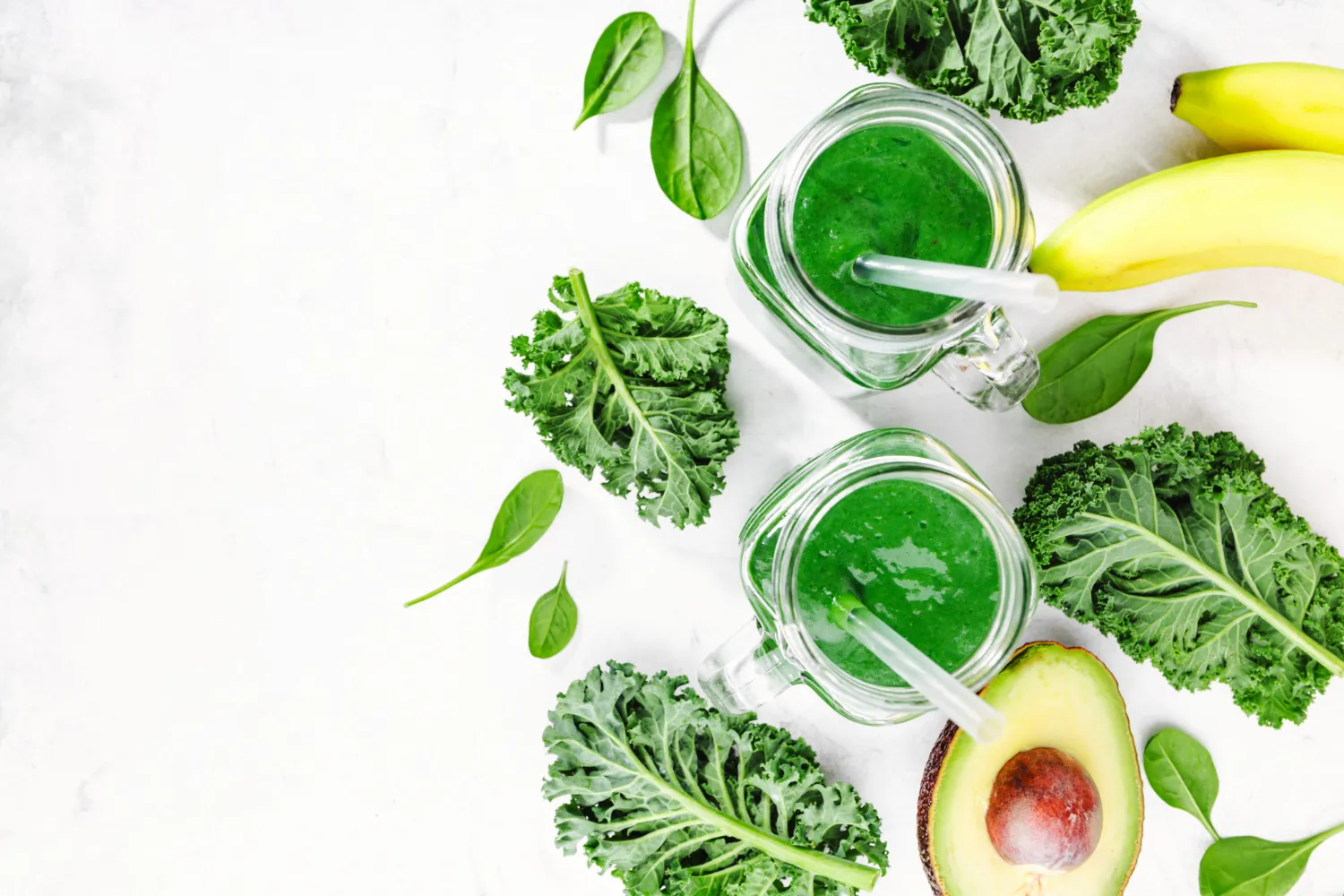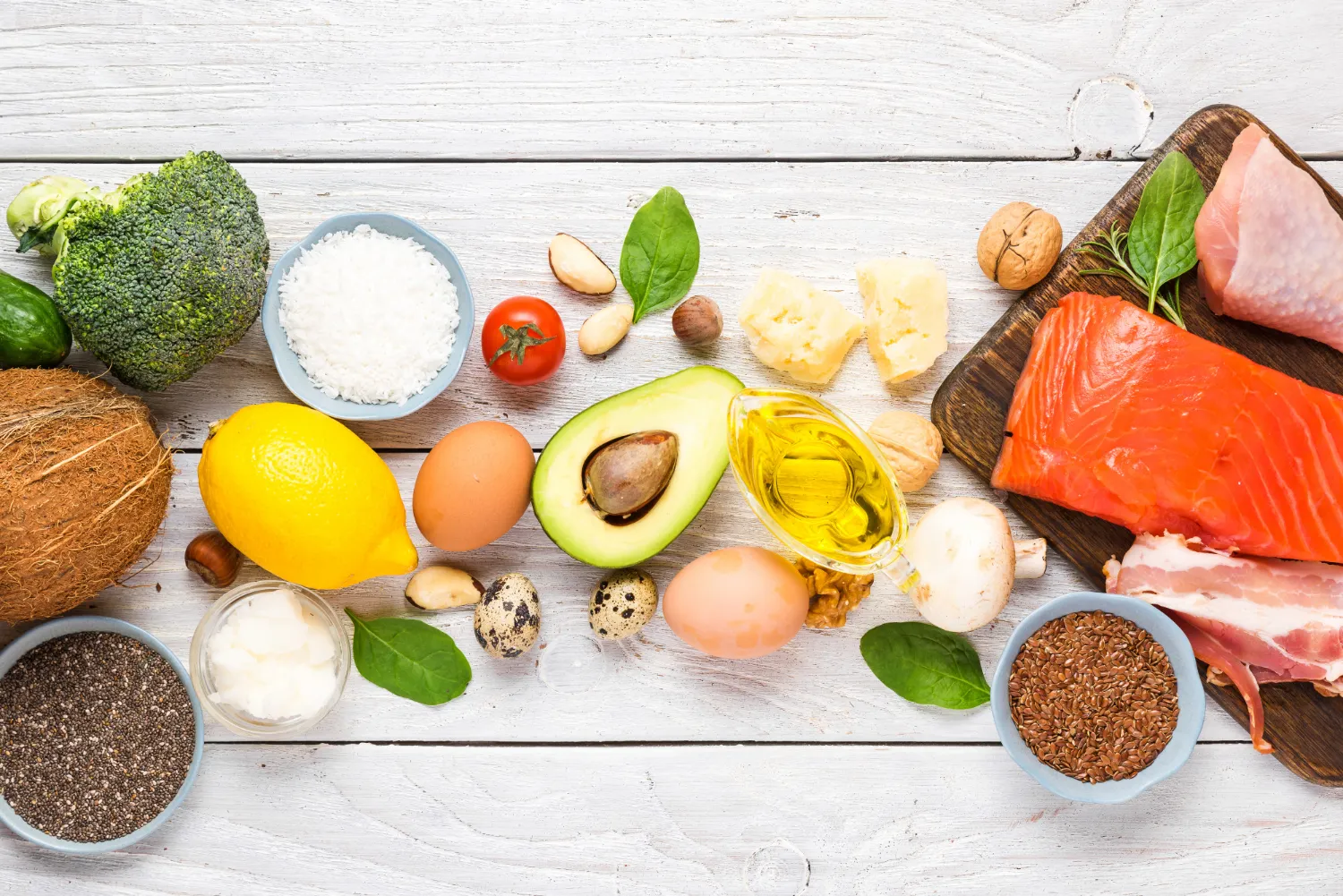Are you currently about to embark on your weight loss journey but don’t know where to start? Then you must try the apple cider vinegar diet.
Apple cider vinegar (ACV) has long been spoken about for its health benefits such as blood sugar regulation, digestion, and fat metabolism.
Even though it is far from a magic bullet (because there isn’t any!) it can still help enhance insulin sensitivity, curb cravings, and reduce inflammation, making it a powerful tool for weight loss.
In this article, we introduce the 7-day apple cider vinegar diet for women. We cover why apple cider vinegar is so popular, how to use it correctly, and how to adjust it for hormonal health.
Why Apple Cider Vinegar Gained Popularity for Weight and Wellness

Apple cider vinegar has gained popularity for its health benefits including blood glucose control, fat metabolism, and digestion. Far from some wild claims and a magic response, much research has been conducted into these claims and promising benefits.
Studies show that both genders undergo a slowing of metabolism by 1–2% after 20 while muscle mass is shown to decline by 3–8% after 30.
However, for women, this is compounded after 40, as they experience major physiological changes due to the decline of estrogen which results in menopause. Evidence shows that this can result in increased appetite and slowing metabolism, leading to weight gain and inflammation.
During this time fat storage shifts from the thighs to the abdomen, which can increase the risk of chronic illnesses including cardiovascular disease, type 2 diabetes, and cancer.
Research indicates that ACV can reduce weight, body mass index, waist-to-hip circumference, body fat ratio, blood glucose, triglyceride, and cholesterol levels in just 12 weeks. Meanwhile, further studies showed that ACV consumption decreased cholesterol and glucose in the blood.
These studies highlight promising benefits that directly aid in weight loss while addressing many components of cardiometabolic disease and weight-related issues.
7 Day Apple Cider Vinegar Diet for Women
This 7-day apple cider vinegar diet has four nutrient-dense meals per day, containing apple cider vinegar as a core ingredient.
The plan is focused on fat loss and is based on a 1,500 kcal daily allowance. Below we have listed the breakdown of calories and macronutrients for each meal.
It should be noted that this is a sample plan and your daily calorie allowance will differ to help you achieve your goals.
Day 1
Breakfast – Apple Cinnamon Protein Yogurt Bowl (400 kcal)
Ingredients:
- ¾ cup nonfat Greek yogurt (100 kcal)
- ½ green apple, chopped (40 kcal)
- ½ scoop vanilla plant-based protein powder (60 kcal)
- 1 tbsp chia seeds (58 kcal)
- 1 tsp almond butter (34 kcal)
- 1 tsp raw honey (21 kcal)
- 1 tbsp chopped walnuts (45 kcal)
- 1 tsp ACV (tossed with apple) (0 kcal)
- Sprinkle of cinnamon (2 kcal)
- Splash of lemon juice (5 kcal)
ACV Benefit: Apple cider vinegar supports morning digestion, helps regulate blood sugar, and enhances nutrient absorption from fiber-rich fruits and seeds.
Lunch – Grilled Chicken & Quinoa Power Bowl with ACV Dressing (400 kcal)
Ingredients:
- 3 oz grilled chicken breast (140 kcal)
- ½ cup cooked quinoa (110 kcal)
- ¼ avocado (60 kcal)
- ½ cup steamed broccoli (27 kcal)
- 1 tsp extra virgin olive oil (45 kcal)
- 1 tbsp chopped parsley + lemon juice (3 kcal)
- 1 tsp ACV (mixed into lemon-herb dressing) (0 kcal)
- Pinch of sea salt + black pepper (5 kcal)
ACV Benefit: Combined with lemon and olive oil, ACV boosts bile production for fat digestion and supports stable energy after a protein-rich meal.
Dinner – Garlic-ACV Glazed Salmon Plate (400 kcal)
Ingredients:
- 3 oz wild salmon (baked) (180 kcal)
- ½ cup roasted sweet potato (90 kcal)
- ½ cup steamed broccoli (27 kcal)
- 1 tsp olive oil (for cooking) (45 kcal)
- 1 tsp ACV (in garlic glaze) (0 kcal)
- Fresh dill + lemon zest (5 kcal)
- Sprinkle of sea salt and pepper (3 kcal)
ACV Benefit: ACV enhances the flavor of the salmon glaze and aids in metabolizing fats while reducing post-meal bloating.
Snack – Berry-Lime Detox Smoothie with ACV (400 kcal)
Ingredients:
- ½ banana (45 kcal)
- ½ cup frozen mixed berries (35 kcal)
- 1 tbsp hemp seeds (55 kcal)
- 1 cup unsweetened almond milk (30 kcal)
- ½ scoop vanilla plant protein (70 kcal)
- 1 tsp raw honey (21 kcal)
- 1 tsp ACV (0 kcal)
- Juice of ½ lime + few mint leaves (2 kcal)
ACV Benefit: Apple cider vinegar pairs with berries and lime to gently support detox, reduce water retention, and help maintain digestive regularity.
Day 2

Breakfast – Savory Greens & Egg Quinoa Bowl (400 kcal)
Ingredients:
- 2 eggs, boiled or soft scrambled (140 kcal)
- ½ cup cooked quinoa (110 kcal)
- ½ cup sautéed spinach (with garlic) (25 kcal)
- 1 tsp olive oil (for spinach) (45 kcal)
- 1 tbsp hemp seeds (58 kcal)
- 1 tsp ACV (splashed over spinach while cooking) (0 kcal)
- Pinch chili flakes + black pepper (2 kcal)
- Squeeze of lemon juice (5 kcal)
ACV Benefit: ACV added to sautéed greens helps optimize digestion, stimulate stomach acid, and improve nutrient absorption from this savory, protein-rich start.
Lunch – ACV Chickpea-Turkey Salad Bowl (400 kcal)
Ingredients:
- 3 oz ground turkey (cooked with herbs) (140 kcal)
- ½ cup canned chickpeas, rinsed (110 kcal)
- ½ cup shredded red cabbage (20 kcal)
- 1 tbsp tahini (90 kcal)
- 1 tsp olive oil (45 kcal)
- 1 tbsp ACV (in tahini dressing) (0 kcal)
- Chopped parsley & lemon juice (5 kcal)
- Pinch of cumin & sea salt (5 kcal)
ACV Benefit: ACV in this creamy tahini dressing balances blood sugar, enhances bile flow, and brings digestive fire to this fiber-packed lunch.
Dinner – Balsamic-ACV Chicken with Roasted Veg (400 kcal)
Ingredients:
- 3 oz grilled chicken breast (140 kcal)
- ½ cup roasted butternut squash (60 kcal)
- ½ cup steamed kale (17 kcal)
- 1 tsp olive oil (used in veg roast) (45 kcal)
- 1 tbsp balsamic vinegar + 1 tsp ACV marinade (5 kcal)
- ¼ avocado, sliced (60 kcal)
- Sprinkle of sesame seeds (10 kcal)
- Garlic, thyme & sea salt (3 kcal)
ACV Benefit: ACV used in the chicken marinade adds a tangy depth while aiding protein digestion, gut health, and liver enzyme activity.
Snack – Creamy Cacao-Avocado Smoothie with ACV (300 kcal)
Ingredients:
- ½ frozen banana (45 kcal)
- ½ avocado (120 kcal)
- 1 tbsp chia seeds (58 kcal)
- 1 tbsp raw cacao powder (12 kcal)
- ½ scoop vanilla or chocolate plant protein (70 kcal)
- 1 tsp ACV (0 kcal)
- ¾ cup unsweetened almond milk (30 kcal)
- Dash of cinnamon + pinch of salt (5 kcal)
ACV Benefit: ACV adds brightness to this creamy blend while supporting liver detox pathways, easing bloating, and stabilizing afternoon energy dips.
Day 3
Breakfast – Apple Cinnamon Protein Oats with ACV (400 kcal)
Ingredients:
- ½ cup rolled oats, cooked in water (150 kcal)
- ½ small green apple, chopped (40 kcal)
- ½ scoop vanilla plant-based protein (70 kcal)
- 1 tbsp almond butter (98 kcal)
- 1 tsp ACV stirred in post-cooking (0 kcal)
- Dash of cinnamon + pinch of sea salt (5 kcal)
- Splash of unsweetened almond milk (15 kcal)
ACV Benefit: A splash of ACV in your oats adds tang and gently supports blood sugar balance, metabolism, and digestion first thing in the morning.
Lunch – Zesty ACV Tuna & White Bean Salad (400 kcal)
Ingredients:
- 3 oz tuna in water, drained (120 kcal)
- ½ cup cooked white beans (110 kcal)
- ½ cup cherry tomatoes, halved (15 kcal)
- ¼ avocado, diced (60 kcal)
- 1 tsp olive oil (45 kcal)
- 1 tbsp ACV + 1 tsp Dijon mustard (5 kcal)
- Chopped red onion & parsley (5 kcal)
- Black pepper & lemon juice (5 kcal)
ACV Benefit: ACV in the dressing enhances mineral absorption, helps reduce post-meal fatigue, and revs up your liver enzymes for a gentle midday cleanse.
Dinner – ACV Chicken Stir Fry with Broccoli & Rice (400 kcal)
Ingredients:
- 3 oz chicken breast, stir-fried (140 kcal)
- ½ cup cooked brown rice (110 kcal)
- ½ cup steamed broccoli (15 kcal)
- ¼ cup shredded carrots (12 kcal)
- 1 tsp sesame oil (45 kcal)
- 1 tbsp tamari + 1 tsp ACV splash (sauce) (5 kcal)
- Minced garlic + ginger (3 kcal)
- Green onion + chili flakes (optional) (5 kcal)
ACV Benefit: ACV in the stir fry sauce supports fat digestion, cuts through heavier proteins, and enhances metabolic function while flavoring the dish.
Snack – ACV Raspberry-Chia Protein Smoothie (400 kcal)
Ingredients:
- ½ banana (45 kcal)
- ½ cup frozen raspberries (35 kcal)
- 1 tbsp chia seeds (58 kcal)
- ½ scoop vanilla plant-based protein (70 kcal)
- 1 tsp ACV (0 kcal)
- ¾ cup unsweetened coconut water (30 kcal)
- 1 tsp almond butter (30 kcal)
- Dash cinnamon & vanilla extract (5 kcal)
ACV Benefit: ACV adds tartness and helps regulate blood sugar, reduce sugar cravings, and nourish the gut lining as part of your evening wind-down.
Day 4

Breakfast – Savory Veggie Egg Scramble with ACV Greens (400 kcal)
Ingredients:
- 2 large eggs – (140 kcal)
- 2 egg whites – (34 kcal)
- ½ cup chopped spinach – (5 kcal)
- ¼ cup diced bell pepper (10 kcal)
- 1 tsp olive oil (45 kcal)
- 1 slice sprouted grain toast (80 kcal)
- 1 tsp ACV + 1 tsp olive oil tossed with a handful of arugula (25 kcal)
- Pinch of salt, pepper, and paprika (5 kcal)
ACV Benefit: Adding ACV to your greens jumpstarts digestion and helps alkalize the body while reducing bloating.
Lunch – Grilled Chicken & Sweet Potato ACV Bowl (400 kcal)
Ingredients:
- 3 oz grilled chicken breast (140 kcal)
- ½ cup roasted sweet potato cubes (90 kcal)
- ½ cup steamed green beans (20 kcal)
- 1 tbsp pumpkin seeds (60 kcal)
- 1 tsp olive oil (45 kcal)
- 1 tbsp ACV + mustard + garlic dressing (10 kcal)
- Sprinkle of herbs and black pepper (5 kcal)
ACV Benefit: ACV in the dressing boosts bile production, helping your body break down fats and absorb nutrients more efficiently.
Dinner – ACV Turkey Lettuce Wraps with Brown Rice (400 kcal)
Ingredients:
- 3 oz lean ground turkey, sautéed (120 kcal)
- ½ cup cooked brown rice (110 kcal)
- 3 large romaine leaves for wraps (10 kcal)
- ¼ cup shredded purple cabbage (10 kcal)
- 1 tsp sesame oil (45 kcal)
- 1 tbsp ACV + coconut aminos (sauce) (5 kcal)
- Minced garlic + green onion + chili flakes (5 kcal)
ACV Benefit: ACV in the sauce sharpens insulin sensitivity and supports healthy blood sugar levels, especially after your final meal of the day.
Snack – Spiced Pear ACV Smoothie (300 kcal)
Ingredients:
- ½ ripe pear (50 kcal)
- ½ frozen banana (45 kcal)
- 1 tbsp hemp seeds (58 kcal)
- ½ scoop vanilla protein powder (70 kcal)
- 1 tsp ACV (0 kcal)
- ¾ cup unsweetened almond milk (30 kcal)
- ½ tsp cinnamon + splash vanilla (5 kcal)
CV Benefit: This gently sweet ACV smoothie delivers hydration and helps reduce late-day sugar cravings while enhancing gut flora.
Day 5
Breakfast – Smoked Salmon & Avocado Toast with ACV Greens (400 kcal)
Ingredients:
- 1 slice sprouted grain bread (80 kcal)
- 2 oz smoked salmon (70 kcal)
- ¼ avocado, mashed (60 kcal)
- 1 boiled egg (70 kcal)
- 1 tsp olive oil (drizzled on greens) (45 kcal)
- 1 tsp ACV tossed with 1 cup arugula + cucumber slices (20 kcal)
- Squeeze of lemon + black pepper (5 kcal)
- ½ scoop unflavored protein in water (side drink) (50 kcal)
ACV Benefit: ACV added to morning greens stimulates digestive juices and promotes a more stable blood sugar response after meals.
Lunch – Grilled Shrimp & Quinoa Detox Bowl with ACV Dressing (400 kcal)
Ingredients:
- 3 oz grilled shrimp (90 kcal)
- ½ cup cooked quinoa (110 kcal)
- ¼ cup grated carrot (12 kcal)
- ¼ cup diced cucumber (8 kcal)
- 1 cup mixed greens (arugula/spinach) (10 kcal)
- 1 tbsp pumpkin seeds (50 kcal)
- 1 tsp olive oil (45 kcal)
- 1 tsp apple cider vinegar + 1 tsp Dijon mustard + herbs (dressing) (10 kcal)
- ½ scoop unflavored protein in water (side drink) (65 kcal)
ACV Benefit: Apple cider vinegar in the dressing enhances nutrient absorption and supports digestion by stimulating stomach acid production.
Dinner – Turkey Lettuce Wraps with Apple Cider Slaw (400 kcal)
Ingredients:
- 3 oz lean ground turkey (cooked with garlic and herbs) (140 kcal)
- 2 large butter lettuce leaves (5 kcal)
- ¼ avocado, sliced (60 kcal)
- ¼ cup shredded red cabbage (10 kcal)
- 1 tbsp tahini (90 kcal)
- 1 tsp apple cider vinegar + ½ tsp honey + mustard (slaw dressing) (10 kcal)
- ½ cup cooked brown rice (served on the side or in wrap) (85 kcal)
ACV Benefit: ACV in the slaw promotes a healthy gut microbiome and may help reduce bloating in the evening.
Snack – ACV Berry Protein Smoothie (300 kcal)
Ingredients:
- ½ banana (45 kcal)
- ½ cup mixed berries (35 kcal)
- 1 tbsp chia seeds (58 kcal)
- 1 cup unsweetened almond milk (30 kcal)
- ½ scoop vanilla plant protein (75 kcal)
- 1 tsp apple cider vinegar + splash of lemon (5 kcal)
- 1 tsp raw honey (optional) (21 kcal)
ACV Benefit: A splash of ACV in your smoothie supports blood sugar balance and adds a gentle detox boost to your snack.
Day 6
Breakfast – Sweet Potato Hash with Eggs & ACV Greens (400 kcal)
Ingredients:
- ½ cup diced, roasted sweet potato (90 kcal)
- 2 large eggs, soft scrambled (140 kcal)
- 1 tsp olive oil (for sautéing) (45 kcal)
- 1 cup baby spinach, lightly wilted (7 kcal)
- ¼ avocado, sliced (60 kcal)
- 1 tsp apple cider vinegar + pinch sea salt (drizzled on greens) (5 kcal)
- ½ scoop plant-based protein in water (side drink) (53 kcal)
ACV Benefit: Apple cider vinegar on greens helps stimulate digestive enzymes and enhance morning metabolism.
Lunch – Lemon-Herb Chicken & Farro Salad with ACV Vinaigrette (400 kcal)
Ingredients:
- 3 oz grilled chicken breast (140 kcal)
- ½ cup cooked farro (100 kcal)
- 1 cup chopped romaine & arugula (10 kcal)
- ¼ cup cherry tomatoes, halved (8 kcal)
- 1 tbsp sunflower seeds (55 kcal)
- 1 tsp olive oil (45 kcal)
- 1 tsp apple cider vinegar + lemon juice + dried oregano (vinaigrette) (10 kcal)
- ½ scoop unflavored protein in water (side drink) (32 kcal)
ACV Benefit: ACV in your vinaigrette promotes satiety and helps regulate post-lunch blood sugar levels.
Dinner – Baked Cod with ACV Kale & Quinoa (400 kcal)
Ingredients:
- 3 oz baked cod with herbs (90 kcal)
- ½ cup cooked quinoa (110 kcal)
- 1 cup steamed kale with garlic (35 kcal)
- 1 tsp flaxseed oil (drizzled over kale) (45 kcal)
- 1 tbsp pumpkin seeds (60 kcal)
- 1 tsp apple cider vinegar + grainy mustard (drizzle on greens) (10 kcal)
- ½ scoop plain protein in water (side drink) (50 kcal)
ACV Benefit: ACV adds digestive support and helps your body break down cruciferous veggies more efficiently.
Snack – ACV Coconut Berry Protein Bowl (300 kcal)
Ingredients:
- ½ cup plain Greek yogurt (80 kcal)
- ½ cup mixed berries (35 kcal)
- 1 tbsp hemp seeds (58 kcal)
- 1 tsp unsweetened shredded coconut (20 kcal)
- ½ scoop vanilla protein powder (72 kcal)
- 1 tsp raw honey (21 kcal)
- 1 tsp apple cider vinegar + squeeze lime (10 kcal)
ACV Benefit: A splash of ACV with lime brightens the bowl, supports gut flora, and assists in post-meal detoxification.
Day 7
Breakfast – Protein Oats with Apple & Almond Butter (400 kcal)
Ingredients:
- ½ cup rolled oats (cooked in water) (150 kcal)
- ½ small green apple, chopped (30 kcal)
- ½ scoop vanilla plant-based protein (60 kcal)
- 1 tsp almond butter (34 kcal)
- 1 tbsp ground flaxseed (37 kcal)
- ¾ cup unsweetened almond milk (30 kcal)
- 1 tsp apple cider vinegar + dash cinnamon (stirred into oats) (5 kcal)
- Squeeze of lemon (optional) (4 kcal)
ACV Benefit: ACV mixed into warm oats supports blood sugar balance and aids morning digestion.
Lunch – Turkey Quinoa Power Bowl with ACV Slaw (400 kcal)
Ingredients:
- 3 oz grilled turkey breast (120 kcal)
- ½ cup cooked quinoa (110 kcal)
- ¼ cup shredded red cabbage (10 kcal)
- ½ cup steamed broccoli (15 kcal)
- ¼ avocado (60 kcal)
- 1 tsp extra virgin olive oil (45 kcal)
- 1 tbsp ACV + Dijon + garlic (for slaw-style dressing) (10 kcal)
- ½ scoop plain protein powder (in water, side drink) (30 kcal)
ACV Benefit: ACV in the cabbage slaw boosts detox enzymes and supports bile flow after your midday meal.
Dinner – Lemon Garlic Chicken with Greens & Sweet Potato (400 kcal)
Ingredients:
- 3 oz lemon-garlic grilled chicken breast (140 kcal)
- ½ cup baked sweet potato (90 kcal)
- 1 cup steamed kale (35 kcal)
- 1 tsp olive oil (45 kcal)
- 1 tbsp hemp seeds (58 kcal)
- 1 tsp apple cider vinegar + lemon juice (over kale) (5 kcal)
- Fresh herbs + black pepper (optional) (2 kcal)
ACV Benefit: ACV and lemon on the greens aid in liver detoxification and enhance mineral absorption.
Snack – Creamy ACV Raspberry Protein Shake (300 kcal)
Ingredients:
- ¾ cup unsweetened almond milk (30 kcal)
- ½ cup frozen raspberries (35 kcal)
- ½ avocado (120 kcal)
- 1 tbsp chia seeds (58 kcal)
- ½ scoop vanilla protein powder (57 kcal)
- 1 tsp raw honey (20 kcal)
- 1 tsp apple cider vinegar + splash lemon (5 kcal)
ACV Benefit: ACV blended into the shake supports gut health and provides a tangy contrast to creamy fats.
How to Use Apple Cider Vinegar the Right Way

When adding ACV to your diet, care is required to ensure you aren’t it. While it does show promising benefits, large amounts can cause digestive issues, esophageal irritation, and damage to tooth enamel.
Below we discuss how to use it the right way to capitalize on its potential benefits with the nasty side effects.
When and How to Take It Safely
To reduce side effects, apple cider vinegar should be consumed diluted with water or added to dressing, sauces, or beverages to avoid potential damage. Adding 1 teaspoon of apple cider to cooking allows you to increase intake safely and dilute the tangy flavour.
Should You Drink It Before or With Meals?
ACV can be consumed before and during meals to support blood sugar control, digestion, and weight management. However, doing so regularly, even when it is diluted with water may irritate the throat.
We recommend adding ACV to your cooking such as dressings, stirred into meals, or mixed into smoothies to dilute it for safe consumption
How Much Is Too Much?
Due to ACV and its potential side effects, no more than 1-2 tablespoons per day should be consumed. We recommend dividing this across meals as 1 teaspoon per meal. If you experience reactions such as throat irritation or tooth enamel erosion, reduce to one tablespoon per day.
Foods That Work Well with Apple Cider Vinegars
Below we list several foods that complement ACV and enhance its benefits.
High-Fiber Meals That Enhance ACV’s Effects
ACV and high-fiber complement each other perfectly. As mentioned, ACV can improve blood sugar control, digestion, and weight management. Meanwhile, fiber is shown to provide similar benefits, improving regularity, regulating blood glucose, and enhancing satiety which can help with weight management.
Lean Proteins and Healthy Fats
Rounding out the ACV diet requires a balanced diet with lean protein and healthy fat. Protein is proven to preserve muscle mass, improve fullness, and increase thermogenesis which is the amount of energy required to digest food.
Meanwhile, sources show that healthy fats provide energy, support hormone production, and nutrient absorption. These are shown to help lower triglycerides, and reduce inflammation and cardiovascular risk.
Protein and healthy fats combined to maintain fullness, which lowers calorie intake, improving weight management,
Anti-Inflammatory Produce and Herbs
Anti-inflammatory produce and herbs pair well with ACV. Foods such as berries, citrus fruits, cruciferous vegetables, and leafy greens.
Meanwhile, studies highlight herbs such as turmeric, ginger, and rosemary for their anti-inflammatory effects.
These foods are not only easy to find at your local supermarket or green grocer, but also easy to combine with ACV to make healthy and delicious meals.
Who Should Be Cautious with ACV
ACV is readily available and contains several health benefits, however, it must be consumed with caution. Below we discuss how to use ACV with acid reflux, gut issues, and medications.
If You Have Acid Reflux or Gut Issues
ACV should be consumed with caution for individuals suffering from acid reflux and gut issues. ACV may help relieve acid reflux by improving digestion, however, these benefits are based on individual experiences with little scientific evidence to support these claims.
If you have acid reflux or gut issues, we recommend starting with small doses (1 teaspoon) diluted in 250 ml of water. If acid reflux and gut issues persist or exacerbate symptoms, reduce the dosage, and frequency of ingestion, or completely stop drinking and consult your healthcare professional.
Interactions with Medications
ACV can interact with several medications including diuretics, digoxin, and diabetes medication. For example, ACV may lower blood sugar levels which lead to dangerously low levels when combined with diabetes medication.
Similarly, ACV and both diuretics and digoxin can lower potassium levels, and when they are combined can lead to low potassium leading to symptoms including constipation fatigue, muscle weakness, and palpitations.
Again, if you are on these medications start with a smaller amount of ACV and monitor energy levels and the occurrence of potential side effects. If symptoms become worse, reduce or stop your intake immediately and seek advice from your healthcare professional.
Safer Alternatives or Modifications
For those looking for a safer alternative for ACV, lemon juice and coconut vinegar provide similar benefits. Lemon juice is shown to support digestion by increasing gastric acid secretion, improving the breakdown of food.
Coconut vinegar on the other hand also contains acetic acid which is present in ACV. Like ACV, it can support blood sugar control, and gut health, improving weight management. Furthermore, it is shown to be a great source of antioxidants, with links to antiobesity and cholesterol reduction.
As mentioned, no more than 1–2 tablespoons of ACV should be consumed per day either diluted in water or added to food. This amount and the frequency of consumption can be lowered to take advantage of its benefits while managing existing conditions to avoid aggravating symptoms.
Adjusting the Plan for Hormonal Health

From what we can see, the ACV diet provides several health benefits. But, how does it affect hormonal health, and does it need to be adjusted? Below, we discuss the ACV diet and the adjustments required for menopause, PCOS, thyroid dysfunction, digestion, and the liver.
During Perimenopause or Menopause
Perimenopause and menopause lead to a decline in estrogen which is shown to increase appetite and shift of fat storage from the thighs to the abdomen. Sadly, this can result in impaired insulin regulation and lead to higher blood sugar, increasing the risk of type 2 diabetes.
The ACV diet requires no changes for perimenopause and menopause as it can help regulate blood sugar, contribute to weight loss, and improve weight-related parameters.
Furthermore, the ACV diet is also fortified by nutrient-dense whole foods containing complex carbohydrates, protein, and healthy fats. All of these are exactly what is needed to manage the challenges of perimenopause and menopause.
However, if you are trying the ACV diet during menopause and are experiencing side effects or aggravated symptoms, stop immediately and contact your licensed healthcare professional.
If You Have PCOS or Thyroid Dysfunction
The ACV diet can help manage PCOS and thyroid dysfunction with only a few adjustments.
Research shows that PCOS is characterized by irregular menstruation, high androgen levels, and small cysts on the ovaries as a result of poor nutrition, lifestyle, and genetics. Those with PCOS encounter obesity, abnormal insulin sensitivity, mood swings, and infertility.
As we know, ACV can help regulate blood sugar and weight, while further studies highlight its ability to improve insulin sensitivity. Effects that prove to be beneficial for addressing PCOS.
Meanwhile, ACV may be able to help with thyroid dysfunction. The thyroid is an endocrine organ that releases hormones for several of the body’s systems and is linked to the gut through what research describes as the diet-gut-thyroid axis.
When the thyroid is dysfunctional with hypothyroidism (underactive), or hyperthyroidism (overactive) can result in fatigue, weight gain, constipation, muscle weakness, mood changes, menstrual irregularities, cold intolerance (hypothyroidism), heat intolerance (hyperthyroidism).
The ACV diet may help alleviate fatigue, gut, and weight-related issues that come from thyroid dysfunction. However, there is little evidence to suggest it is a viable treatment method.
If you have thyroid issues and want to try the ACV diet, we recommend halving the serving size to 1 tablespoon per day (½ teaspoon each meal) and gradually increasing.
Supporting Digestion and Liver Detox Pathways
As we know, ACV can support digestion, but what also is interesting is that it may help support liver health.
The liver is tasked with regulating metabolism and removal of toxins, and drugs. However, poor diet, excessive alcohol, drugs, and illness are shown to lead to liver damage. Additional sources explain that when the liver is exposed to toxins it can release free radicals into the body, damaging the liver and deteriorating function.
The antioxidants found in ACV help prevent and protect against damage caused by free radicals. If you are currently experiencing issues with digestion or the liver, consult your doctor for advice.
Recap: Apple Cider Vinegar as a 7-Day Metabolic Ally
The ACV vinegar diet gathers its strength from a combination of amazing health benefits and nutrient-dense whole food. While it is far from instant, it can set the foundation of health nutrition practices which can lead to greater longevity.
What ACV Can and Can’t Do
ACV has shown promising benefits for blood sugar, digestion, weight loss, and fat metabolism. However, it is far from a magic pill and by no means a hack to rapid weight loss. What makes the apple cider so effective is that it is coupled with nutrient-dense whole foods which provide benefits such as improved satiety, blood sugar regulation, digestion, and hormone support.
Long-Term Habits to Build from This Week
One thing that should be noticed is that the 7-day apple cider vinegar duet is incredible for building healthy habits.
As mentioned, it’s built on nutrient-dense whole foods and the practices that support a balanced diet. Habits that can be taken away to help you improve your nutrition.
As for ACV, you can continue to add it to your meals so long as you don’t exceed the recommended 1–2 tablespoons per day. If you aren’t particularly fond of adding it to your meals but still want the benefits, consider reducing it to 1 tablespoon per day across all meals, or even having it every second day.
When You Might See Results or Feel Changes
The ACV diet is no quick fix, meaning that its potential benefits such as blood sugar regulation and weight loss won’t happen overnight. However, during the initial week, changes to digestion happen as feelings of bloating and acid reflux may decline.
The key is to not get hung up on major results as this isn’t a quick fix. We recommend being patient and sticking to the diet even in a modified capacity for the following weeks and months and over time you will begin to reap the rewards.
Sources
- Manini TM. Energy expenditure and aging. Ageing Res Rev. 2010 Jan;9(1):1-11. doi: 10.1016/j.arr.2009.08.002. Epub 2009 Aug 19. PMID: 19698803; PMCID: PMC2818133. https://pmc.ncbi.nlm.nih.gov/articles/PMC2818133/
- Volpi E, Nazemi R, Fujita S. Muscle tissue changes with aging. Curr Opin Clin Nutr Metab Care. 2004 Jul;7(4):405-10. doi: 10.1097/01.mco.0000134362.76653.b2. PMID: 15192443; PMCID: PMC2804956. https://pmc.ncbi.nlm.nih.gov/articles/PMC2804956/
- Opoku, A.A., Abushama, M. and Konje, J.C., 2023. Obesity and menopause. Best Practice & Research Clinical Obstetrics & Gynaecology, 88, p.102348. https://doi.org/10.1016/j.bpobgyn.2023.102348. https://www.sciencedirect.com/science/article/pii/S1521693423000482
- Abou-Khalil R, Andary J, El-Hayek E. Apple cider vinegar for weight management in Lebanese adolescents and young adults with overweight and obesity: a randomised, double-blind, placebo-controlled study. BMJ Nutr Prev Health. 2024 Mar 12;7(1):61-67. doi: 10.1136/bmjnph-2023-000823. PMID: 38966098; PMCID: PMC11221284. https://pmc.ncbi.nlm.nih.gov/articles/PMC11221284/
- Hadi A, Pourmasoumi M, Najafgholizadeh A, Clark CCT, Esmaillzadeh A. The effect of apple cider vinegar on lipid profiles and glycemic parameters: a systematic review and meta-analysis of randomized clinical trials. BMC Complement Med Ther. 2021 Jun 29;21(1):179. doi: 10.1186/s12906-021-03351-w. PMID: 34187442; PMCID: PMC8243436. https://pmc.ncbi.nlm.nih.gov/articles/PMC8243436/
- Halton TL, Hu FB. The effects of high protein diets on thermogenesis, satiety and weight loss: a critical review. J Am Coll Nutr. 2004 Oct;23(5):373-85. doi: 10.1080/07315724.2004.10719381. PMID: 15466943. https://pubmed.ncbi.nlm.nih.gov/15466943/
- Office of Dietary Supplements (ODS), 2024. Omega-3 Fatty Acids: Fact Sheet for Health Professionals. National Institutes of Health. https://ods.od.nih.gov/factsheets/Omega3FattyAcids-HealthProfessional/
- Krupa, K.N., Fritz, K. & Parmar, M., 2024. Omega-3 Fatty Acids. In: StatPearls [Internet]. Treasure Island (FL): StatPearls Publishing. https://www.ncbi.nlm.nih.gov/books/NBK560589/
- Ghasemian M, Owlia S, Owlia MB. Review of Anti-Inflammatory Herbal Medicines. Adv Pharmacol Sci. 2016;2016:9130979. doi: 10.1155/2016/9130979. Epub 2016 May 10. PMID: 27247570; PMCID: PMC4877453. https://pmc.ncbi.nlm.nih.gov/articles/PMC4877453/
- Freitas, D., Boué, F., Benallaoua, M. et al. Glycemic response, satiety, gastric secretions and emptying after bread consumption with water, tea or lemon juice: a randomized crossover intervention using MRI. Eur J Nutr 61, 1621–1636 (2022). https://doi.org/10.1007/s00394-021-02762-2. https://link.springer.com/article/10.1007/s00394-021-02762-2?cjdata=MXxOfDB8WXww&utm_medium=affiliate&utm_source=commission_junction&utm_campaign=CONR_BOOKS_ECOM_GL_PBOK_ALWYS_DEEPLINK&utm_content=textlink&utm_term=PID100090071&CJEVENT=f44825f0509711f0806000480a18b8f6#citeas
- Malakul W, Seenak P, Jumroon N, Arikit S, Kumphune S, Nernpermpisooth N. Novel Coconut Vinegar Attenuates Hepatic and Vascular Oxidative Stress in Rats Fed a High-Cholesterol Diet. Front Nutr. 2022 Mar 9;9:835278. doi: 10.3389/fnut.2022.835278. PMID: 35356733; PMCID: PMC8959456. https://pmc.ncbi.nlm.nih.gov/articles/PMC8959456/
- Wu D, Kimura F, Takashima A, Shimizu Y, Takebayashi A, Kita N, Zhang G, Murakami T. Intake of vinegar beverage is associated with restoration of ovulatory function in women with polycystic ovary syndrome. Tohoku J Exp Med. 2013 May;230(1):17-23. doi: 10.1620/tjem.230.17. PMID: 23666047. https://pubmed.ncbi.nlm.nih.gov/23666047/
- Shulhai AM, Rotondo R, Petraroli M, Patianna V, Predieri B, Iughetti L, Esposito S, Street ME. The Role of Nutrition on Thyroid Function. Nutrients. 2024 Jul 31;16(15):2496. doi: 10.3390/nu16152496. PMID: 39125376; PMCID: PMC11314468. https://pmc.ncbi.nlm.nih.gov/articles/PMC11314468/
- Sharma, A. & Nagalli, S., 2023. Chronic Liver Disease. In: StatPearls [Internet]. Treasure Island (FL): StatPearls Publishing. https://www.ncbi.nlm.nih.gov/books/NBK560299/
- Kandeel S, Elkaliny HH. The Possible Protective Effect of Apple Cider Vinegar on Mercuric Chloride-Induced Changes on Rat Hepatocytes: Immunohistochemical and Ultrastructure Study. J Microsc Ultrastruct. 2020 Sep 10;8(3):126-131. doi: 10.4103/JMAU.JMAU_63_19. PMID: 33282688; PMCID: PMC7703014. https://pmc.ncbi.nlm.nih.gov/articles/PMC7703014/
FAQs
How much weight can I realistically lose on this 7-day diet?
This plan is best viewed as a short-term "reset" to kickstart healthier habits. While you might notice a drop of a few pounds on the scale, this is often due to reduced water retention and bloating. The primary goal is not rapid fat loss, but to support digestion and build momentum for a more sustainable, long-term health plan.
How do I drink apple cider vinegar safely?
This is extremely important. You should never drink apple cider vinegar straight, as it can damage your tooth enamel and esophagus. Always dilute 1-2 tablespoons of ACV in a large glass of water. It's also a good idea to drink it with a straw and rinse your mouth with plain water afterwards.
Will I be consuming only apple cider vinegar for 7 days?
Absolutely not. Apple cider vinegar is a supplement to a healthy diet, not a replacement for food. This 7-day plan includes a full schedule of balanced, low-calorie meals rich in protein, fiber, and nutrients. The ACV is simply incorporated at specific times to support the diet's goals.
What are the actual benefits of including ACV in my diet?
While not a magic bullet, some studies suggest that apple cider vinegar may help with appetite control, support healthy digestion, and aid in blood sugar regulation. When used as part of a healthy, whole-foods diet, it can be a useful tool to help you feel fuller and reduce cravings.
What should I do after the 7 days are over?
The 7-day plan is a temporary kickstart. The real goal is to use it as a bridge to a more sustainable lifestyle. After the week is over, we guide you on how to continue with a balanced diet, focusing on the whole foods you ate during the plan, while you can choose to continue using diluted ACV in a moderate, safe way if you found it beneficial.














